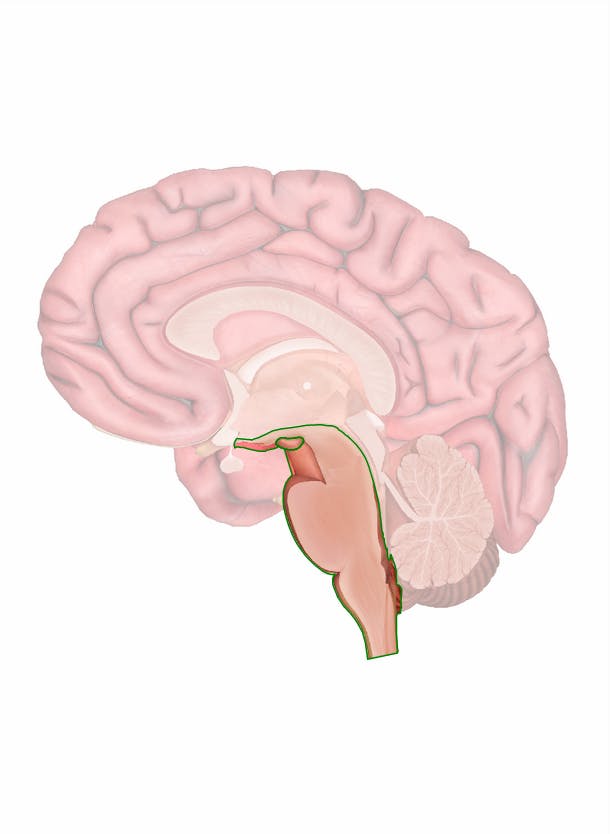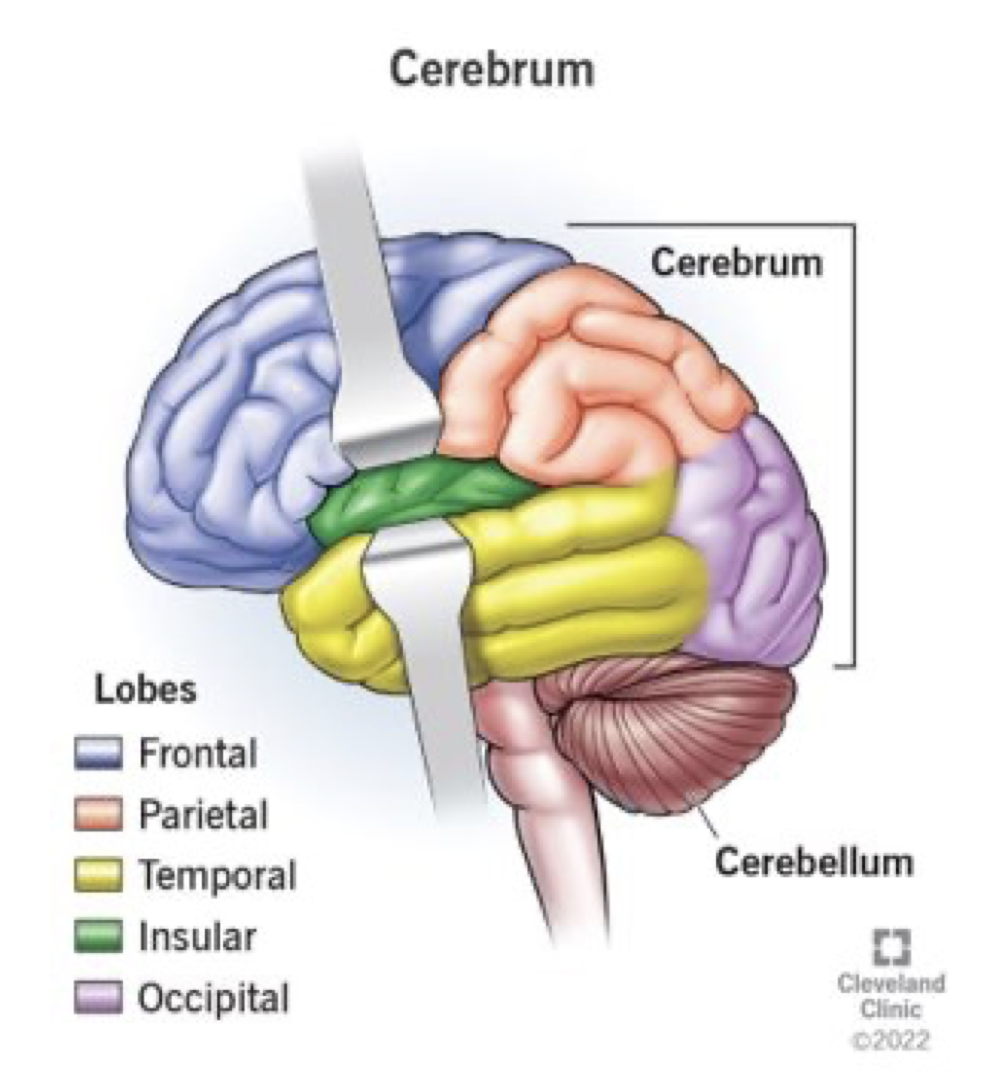chapter 13: the brain and cranial nerves
0.0(0)
Card Sorting
1/36
There's no tags or description
Looks like no tags are added yet.
Study Analytics
Name | Mastery | Learn | Test | Matching | Spaced |
|---|
No study sessions yet.
37 Terms
1
New cards
brain
* part of CNS contained in cranial cavity
* control venter for many body functions
* much like. complex computer but more
* parts of the brain
* brainstem, cerebellum, diencephalon, cerebruh
* cranial nerves
* control venter for many body functions
* much like. complex computer but more
* parts of the brain
* brainstem, cerebellum, diencephalon, cerebruh
* cranial nerves
2
New cards
brainstem (connects spinal cord to brain)
integration of reflexes necessary for survival

3
New cards
cerebellum (attached to the brainstem posterior to pons)
* involved in the control of locomotion, balance, posture
* can “learn” highly specialized motor functions through specific, repeated comparator activities
* proprioceptive neurons provide info. about location/position of the body constantly
* compares actual movement with intended movement and can correct to make movements smooth
* can “learn” highly specialized motor functions through specific, repeated comparator activities
* proprioceptive neurons provide info. about location/position of the body constantly
* compares actual movement with intended movement and can correct to make movements smooth
4
New cards
diencephalon
* located between the brainstem and cerebellum
* components: thalamus, subthalamus, epithalamus, hypothalamus
* components: thalamus, subthalamus, epithalamus, hypothalamus
5
New cards
cerebrum
constant thought, control
6
New cards
cranial nerves
* part of PNS, arise directly from brain
* 2 pairs arise from the cerebrum
* 10 pairs arise from the brainstem
* 2 pairs arise from the cerebrum
* 10 pairs arise from the brainstem
7
New cards
brainstem parts
midbrain, pons, medulla oblangata
8
New cards
brainstem: medulla oblongata
regulates: HR, BV diameter, respiration, swallowing, vomiting, hiccuping, coughing, sneezing
9
New cards
brainstem: pons
* sleep center (initiates REM)
* respiratory center coordinates with center in medulla
* respiratory center coordinates with center in medulla
10
New cards
brainstem: midbrain
hearing, visual reflexes, turn eyes/head, visual tracking of moving objects, unconscious regulation and coordination of motor activities
* small
* small
11
New cards
thalamus
* serves as a relay center for sensory and motor impulses between the spinal cord and medulla oblongata, and the cerebrum
* it recognizes sensory impulses of **heat, cold, pain, pressure, etc.**
* it recognizes sensory impulses of **heat, cold, pain, pressure, etc.**
12
New cards
frontal lobe
* voluntary motor function, motivation, aggression, sense of smell, mood, personality, decision making
13
New cards
parietal lobe
reception and evaluation of sensory information except smell, hearing, and vision
14
New cards
occipital lobe
reception and integration of visual input
15
New cards
temporal lobe
reception and evaluation of smell and hearing; memory, abstract thought, judgement
16
New cards
insular lobe
deep, taste (sometimes called the 5th lobe)

17
New cards
cerebrospinal fluid (CSF)
* similar to serum, but most protein removed
* bathes brain and spinal cord
* protective cushion around CNS
* blood-cSF barrier
* bathes brain and spinal cord
* protective cushion around CNS
* blood-cSF barrier
18
New cards
blood-cerebrospinal fluid barrier
* endothelial cells of capillaries attached by tight junctions
* substances do not pass between cells
* substances must pass through cells
* makes the barrier very selective
* substances do not pass between cells
* substances must pass through cells
* makes the barrier very selective
19
New cards
blood supply to the brain
* brain requires a tremendous amount of blood
* receives 15-20% of blood pumped by heart
* interruption can cause unconsciousness and irreversible brain damage
* high metabolic rate; dependent upon constant supply of oxygen and glucose
* blood-brain barrier
* receives 15-20% of blood pumped by heart
* interruption can cause unconsciousness and irreversible brain damage
* high metabolic rate; dependent upon constant supply of oxygen and glucose
* blood-brain barrier
20
New cards
blood-brain barrier
* capillary endothelial cells along with astrocytes and basement membrane
* to be considered when developing drugs
* to be considered when developing drugs
21
New cards
cranial nerves
* indicated by roman numerals I-XII from anterior and posterior
* may have one or more of 3 functions
* may have one or more of 3 functions
22
New cards
3 functions of cranial nerves
sensory, somatic motor, parasympathetic
23
New cards
sensory
special or general
24
New cards
somatic motor
* control of skeletal muscles
* proprioception (position of various body parts, including joints and muscles (input to brain))
* proprioception (position of various body parts, including joints and muscles (input to brain))
25
New cards
parasympathetic function of cranial nerves
regulation of glands, smooth muscles, cardiac muscle
26
New cards
olfactory
smell
27
New cards
optic
vision
28
New cards
vestibulococholear
hearing and balance
29
New cards
trochlear
eye muscles
30
New cards
abducens
eye muscles
31
New cards
accessory
neck, throat, shoulder
32
New cards
hypoglossal
tongue
33
New cards
trigeminal
facial muscles and receptors
34
New cards
oculomotor
eye muscles (pupil dilation)
35
New cards
facial
facial muscles and receptors
36
New cards
glossopharyngeal
mouth and throat
37
New cards
vagus
digestion, heart rate, etc.